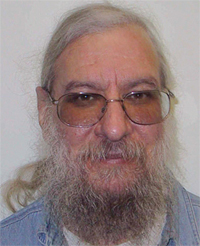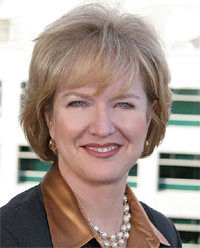Mobile DTV Moves
ALEXANDRIA, VA.
Now that ATSC Mobile proponents have essentially wrapped up their months-long consumer "showcase" of field trials in the Washington, D.C. market, broadcasters now must get serious about what type of mobile content to offer their viewers. Apart from merely simulcasting a station's on-air programming, some industry experts say a savvy mix of live and non-real time content could be crucial to ATSC Mobile's success.

Rich Chernock, CTO, Triveni Digital "I think a lot of broadcasters are now trying to figure out, 'How am I going to make a business of this?'" said Rich Chernock, chief technology officer for Triveni Digital. "Some may be thinking, 'It's just another broadcast. Let's just take what we have on the air and simply simulcast it. Then I've filled in my mobile channel and that's great.' Well, I can see the attraction to that, to begin with, because you're experimenting and no one's quite sure how it's going to work. That's the easiest path. But there are some other possible considerations [because] mobile TV is different from fixed TV," Chernock said.
Eventually, Chernock believes, non-real time is going to become "a key part" of ATSC Mobile's allure, where content is pushed to mobile receivers and cached before consumption, although he sees real-time fare such as local news remaining an important success dynamic. "I'm not suggesting [downloaded] content will replace real-time broadcast, but it could supplement it," Chernock said. "People are always going to want live local news in real time."
THE FLO LESSON
In fact, Chernock sees local content as a unique advantage that broadcasters hold over virtually all existing national services—including FLO TV, a highly publicized non-local content provider that's now on its deathbed. "FLO TV failed because of a lack of local television, in my opinion," Chernock said.
Industry consultant and journalist Pete Putman concurs that lack of local content played a big role in FLO TV's demise: "There's a statistic that says a majority of automobile trips range no farther than 25 miles from home," Putman. Pedestrian trips cover a much smaller distance, so a mobile TV user expects to check out local news, traffic, weather and sports scores — not CNN, Nickelodeon, and so on."
Yet the key negative working against FLO's success, Putman said, was its price. "It's too expensive. The FLO portable LCD set was about $250, and with the minimum three-year, $9 per month service contract, consumers were on the hook for a total of $574 to get about a dozen channels of cable/satellite-only networks. A smart phone today with Internet access costs a lot less money and can access numerous video streams from the Web. And consumers also can buy portable [non-mobile] digital TV sets for about $100 that receive local stations for free," Putman said. Failure to offer much content in "bite-sized nuggets" is another reason Putman cites for FLO TV's demise.
Colleen Brown, president/CEO of Fisher Communications in Seattle, and chairman of the recently formed Mobile500 Alliance, believes the right combination of real-time local and national programming is the "killer app" for broadcasters. "That being said, we fully recognize the value and consumer demand for premium services—such as being able to time-shift content and to combine TV viewing with the functionality of the Internet," Brown said.
The alliance, which will help promote ATSC Mobile in conjunction with the Open Mobile Video Coalition, was formed in September. Brown said it comprises 30 broadcast companies representing nearly 350 local stations in 65 markets of all sizes (as of mid-October). "We need to walk before we run—and getting the 'live part' right is important," Brown said. "[In time], there will be various 'hybrid' device platforms that support live and non-real time content, as well as various interactive 'push-pull' applications that can drive new sources of revenue."
Brown underscored the point that the terrestrial aspect of ATSC Mobile creates technical efficiencies. "We're talking live broadcast content—not one-to-one 'uni-casting' across a carrier's infrastructure. Secondly, this [ATSC] standard was designed for mobile and there are no other local broadcast 'apps' that do that. ATSC A/153 is the only way you can support the ability for literally everyone in a coverage area to be able to tune into live events on-the-go. Wireless carriers cannot deliver that 'one-to-many' service…" Brown said.

Colleen Brown, president, Fisher Communications Brown added that the new alliance is making "significant progress" in identifying a sustainable business model for ATSC Mobile. "We've had a number of positive discussions with device manufacturers and content providers."
FORMALIZED MOBILE PLAY
Allison Dollar, CEO of the Interactive Television Alliance and executive director of the annual Mobile Excellence Awards, said "broadcasters move slowly, but they're not fools. It's clear the industry needs a formalized mobile play. The Mobile500 Alliance is certainly an idea whose time has come, but whether or not the consumption is in real time isn't so much the issue. There's a big playground of hybrid business models to explore that have emerged through online video," Dollar said. "I think non-real time can be profitable. But more to the point is whether, with whom, and how this [broadcast] group and its constituents work with the rest of the stakeholders."
OMVC Executive Director Anne Schelle, like Chernock and Brown, also sees a lot of real-time content as vital to success. "When you say 'TV' to a typical consumer, what you're really saying is 'live broadcast television,'" said Schelle. "If I'm watching an interview at 8 a.m. on 'Today,' I want to be able to continue viewing that interview when I walk out the door. Local news was the most accessed genre on the Samsung Moment [handheld mobile device] during our recent D.C. Showcase."
Schelle, too, believes mixing in some non-real time content "totally makes sense" for local broadcasters. "Non-real time is a great complement to live TV. Think printed content, think VOD to be stored, think of an IPTV [Internet] platform where you can do widgets embedded within EPGs," Schelle said.
As for the rollout of ATSC Mobile, Schelle said limited product will be available this coming holiday season—"but 2011 is where we'll really see a pick-up in [handheld] devices. These are still early days."
Get the TV Tech Newsletter
The professional video industry's #1 source for news, trends and product and tech information. Sign up below.
